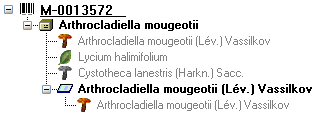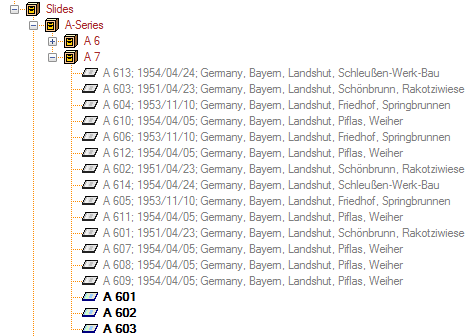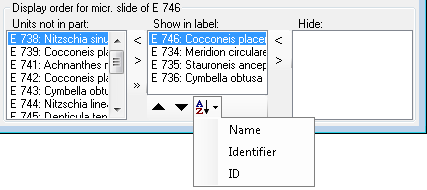Diversity Collection
Part
Parts of the specimen
A specimen can contain several parts which may be stored in several
collections. These parts may represent different material categories,
e.g. herbarium sheets, microscopic slides etc. The parts are shown in
the part tree under the main tree. This tree depicts the parts either in
accordance to their relation to each other in the specimen tree (click
on the  icon in the panel on the left) - see
first image below - or in relation to the collections where the parts
are stored (click on the
icon in the panel on the left) - see
first image below - or in relation to the collections where the parts
are stored (click on the  icon in the panel on
the left) - see second image below. Here the two parts of the specimen
are located in two collections. To add a new part use the drop-down
field
icon in the panel on
the left) - see second image below. Here the two parts of the specimen
are located in two collections. To add a new part use the drop-down
field  in the panel on the right of the
tree and choose the material category of the new part. The material
categories which appear in this list can be customized.
You can set the a default collection for new parts. If
the default collection is not set, you will be asked to name the
collection of the new part. If the part is derived from another part,
select this in the tree before creating the new part. The new part will
then be added as a child of the old part. You can later edit these
relations by drag & drop. If you wish to create a copy of a part, use
the
in the panel on the right of the
tree and choose the material category of the new part. The material
categories which appear in this list can be customized.
You can set the a default collection for new parts. If
the default collection is not set, you will be asked to name the
collection of the new part. If the part is derived from another part,
select this in the tree before creating the new part. The new part will
then be added as a child of the old part. You can later edit these
relations by drag & drop. If you wish to create a copy of a part, use
the  button in the panel on the right side of the
tree. To insert parts when the tree is hidden use the
button in the panel on the right side of the
tree. To insert parts when the tree is hidden use the  button and follow the upcoming dialogs. As
another option you can transfer all specimens in the result list of a
query via the menu Data -
button and follow the upcoming dialogs. As
another option you can transfer all specimens in the result list of a
query via the menu Data -  Transfer -
Transfer -  To collection ... into a collection. Please keep in mind
that next to adding part existing part will be transferred to the
selected collection as well.
To collection ... into a collection. Please keep in mind
that next to adding part existing part will be transferred to the
selected collection as well.



Subcollection
To see the whole content of a collection, click on the
 button. All specimens within the
collections will be listed as shown below with e.g. their accession
number, accession number of the part, storage location, collection date
and/or locality as set in Customize
button. All specimens within the
collections will be listed as shown below with e.g. their accession
number, accession number of the part, storage location, collection date
and/or locality as set in Customize
 .
.

Display order
If an organism is present in a part of the specimen, it will be shown in
the tree. To edit its presence select the specimen part in the tree and
edit the Display order as shown below.

In the example above, all organisms are present in the specimen.
However, the fungus Cystotheca lanestris was chosen not to appear on
the label and was transferred to the Hide list. This is symbolized
by a grey icon  in the tree. You may enter a
description for an organism as a whole or for
the organism within a certain part. The slide, symbolized by the
in the tree. You may enter a
description for an organism as a whole or for
the organism within a certain part. The slide, symbolized by the
 icon, was created from the sample. Thus, in the
specimen tree it is shown as a child of the specimen symbolized by the
icon, was created from the sample. Thus, in the
specimen tree it is shown as a child of the specimen symbolized by the
 icon. Concerning the organisms only the
fungus Arthrocladiella is found on the slide. Thus, in the tree it is
the only organism shown as child of the slide. In the display order the
two other organisms appear in the Units not in part list (see
below).
icon. Concerning the organisms only the
fungus Arthrocladiella is found on the slide. Thus, in the tree it is
the only organism shown as child of the slide. In the display order the
two other organisms appear in the Units not in part list (see
below).

To move the organisms between the lists use the > and <
buttons. In the list Show in label you may change the sequence of
the organisms with the  and
and  buttons in the panel at the base of the list. The organism at the top
will be the one taken as the main organism, e.g. for printing a label.
buttons in the panel at the base of the list. The organism at the top
will be the one taken as the main organism, e.g. for printing a label.
To see changes of the stock of the part click on the button
 . A window will open listing all previous volumns
together unit, the date and the responsible user.
. A window will open listing all previous volumns
together unit, the date and the responsible user.
To change the sequence of the parts according to e.g. the name instead
of setting all entries one by one, you may choose among the options
shown in the image below (Name, Identifier, ID).

Details
To edit the details of a part select it in the tree to open the fields
as shown below.

The identifier, e.g. the taxonomic name under which the specimen can be
found in the collection is entered in the field Storage location.
You can search for this entry in the query.
With the template you can define  and
copy
and
copy  predefined values into the data (see
chapter Template).
predefined values into the data (see
chapter Template).
To search for a free accession number use the  button (see chapter Accession). To enter the storage
location you may use the drop-down button
button (see chapter Accession). To enter the storage
location you may use the drop-down button  to
select from e.g. the identifications within the specimen. The source for
the list can be specified under Administration - Customize display ... (see below).
to
select from e.g. the identifications within the specimen. The source for
the list can be specified under Administration - Customize display ... (see below).

The drop-down button  for the Notes will
provide you with a list of all entries in this field, filtered with your
entry in the text field. You may use wildcards like "%" or "_" (see
Wildcards).
for the Notes will
provide you with a list of all entries in this field, filtered with your
entry in the text field. You may use wildcards like "%" or "_" (see
Wildcards).
Collection
In the collection tree, the specimens are shown with their dependence
upon each other based on their location in Collections. To get
information about a collection simply select it in the tree. If you have
the required rights, you may use the  button
to open the administration of the collections. This form is accessible
under the menu entry Administration -
Collections... as
well.
button
to open the administration of the collections. This form is accessible
under the menu entry Administration -
Collections... as
well.
Material
The material category of a specimen part is indicated by the icon in
the hierarchy.
Here some examples:
 bones: bones or skeleton from vertebrates
bones: bones or skeleton from vertebrates
 cultures: living cultures of organisms
cultures: living cultures of organisms
 drawing: original line or color drawing
drawing: original line or color drawing
 herbarium sheets: capsules or sheets as
stored in a botanical collection
herbarium sheets: capsules or sheets as
stored in a botanical collection
 icons: icons, images etc. stored in a botanical
collection
icons: icons, images etc. stored in a botanical
collection
 micr. slide: glass plate with sections of specimen
for microscopic studies
micr. slide: glass plate with sections of specimen
for microscopic studies
 specimen: specimen stored in a collection\
specimen: specimen stored in a collection\
Transaction and processing
Specimens can be included in a transaction. Every
stored part of a specimen may be treated with several
processings.
Images
If there are images which are related to the
current part, the button for the restriction of the images will be
enabled (  →
→  ). Click on
it to restrict the images to this part. The button will receive a red
background
). Click on
it to restrict the images to this part. The button will receive a red
background  to
remind you of the restriction and in the image list a button
to
remind you of the restriction and in the image list a button
 will appear which enables you to show all
images.
will appear which enables you to show all
images.
Editing in tables
To edit the parts of the specimens in a table see the chapter Grid forparts, use the  Table
editor for the
Table
editor for the  Part
table or the
Part
table or the  Part sheet from the
Part sheet from the
 Spreadsheets.
Spreadsheets.
The data is stored in the table
CollectionSpecimenPart.









 button. All specimens within the
collections will be listed as shown below with e.g. their accession
number, accession number of the part, storage location, collection date
and/or locality as set in Customize
button. All specimens within the
collections will be listed as shown below with e.g. their accession
number, accession number of the part, storage location, collection date
and/or locality as set in Customize



 in the tree. You may enter a
description for an organism as a whole or for
the organism within a certain part. The slide, symbolized by the
in the tree. You may enter a
description for an organism as a whole or for
the organism within a certain part. The slide, symbolized by the






















 →
→ 





